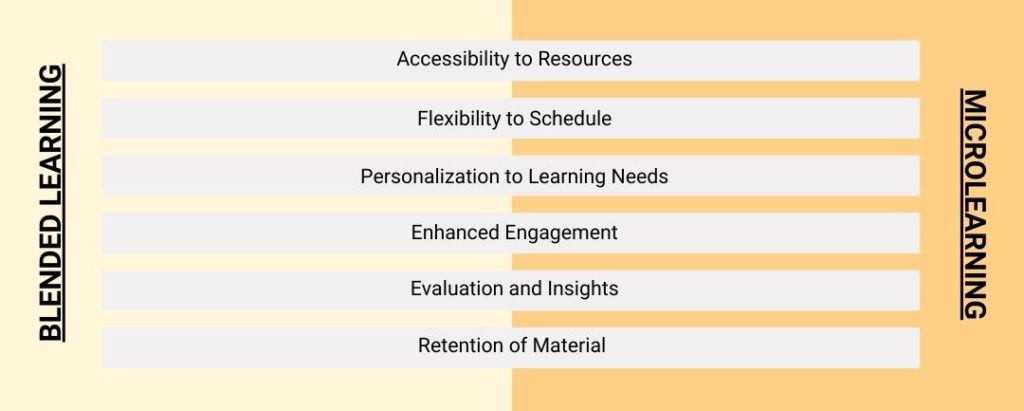
Blended learning is a method of imparting learning that combines in-person instruction with online learning activities. It integrates technology with traditional classroom methods to enhance the learning journey. The highlight of a blended learning approach is the ability for a learner to self-pace and hold control over their experience. This could involve online discussions, instructional videos, interactive modules, or virtual simulations, while still offering the opportunity to interact face-to-face with teachers and peers.
With the flexibility and customization of blended learning, the learning process can accommodate diverse learning styles, provide opportunities for self-directed learning, and foster collaboration and critical thinking skills.
The importance of blended learning includes:
- Flexibility: Apart from deciding when and where the learning can take place, students can access materials and participate in online activities. This flexibility is particularly beneficial for adult learners, working professionals, and students with busy schedules or diverse learning needs.
- Personalization: Educators are given the option of tailoring the courses to individual student needs. Online learning platforms can provide personalized learning paths, adaptive assessments, and targeted feedback based on student performance and preferences, hence improving outcomes.
- Access to Resources: With increased access to a range of resources and materials beyond the limitations of traditional classroom settings, users can access multimedia resources, interactive simulations, and online libraries to supplement their learning experience.
- Enhanced Engagement: The combination of interactive and multimedia elements increases the engagement of students throughout the learning journey. Online discussions, collaborative projects, and interactive simulations provide opportunities for students to apply concepts, solve problems, and engage with course content in meaningful ways.
- Preparation for the Digital Age: The development of digital literacy skills and familiarity with online tools and technologies helps students prepare for an increasingly digital landscape. This emphasizes the need for proficiency in navigating online resources, collaborating in virtual environments, and leveraging digital tools for professional success.
However, the success of such an educational approach depends on the thorough and strategic implementation. Here are a few best practices that educators can apply:
- Balanced Blend of Engaging Content: With a blend of online and face-to-face components, each element of learning complements the other. Incorporate a variety of resources such as videos, simulations, quizzes, readings, and interactive exercises to cater to different learning styles and preferences.
- Interactive Online Activities: Foster collaboration, discussion, and interaction among learners in online environments. Use discussion forums, virtual classrooms, group projects, and collaborative tools to facilitate meaningful peer-to-peer and instructor-student interactions.
- Flexibility of Scheduling: Provide flexibility in terms of pace and scheduling to accommodate diverse learner needs and preferences, improving learning outcomes and meeting objectives.
- Integration of Technology: With user-friendly learning management systems (LMS), communication tools, and educational software, the learning objectives can be maintained at the forefront of educational efforts. (https://nuvedalearning.com/calfv4/)
- Continuous Evaluation and Improvement: Gather insights for each student throughout the learning journey to assess effectiveness and identify areas for improvement.
Alongside blended learning exists another impactful approach to incorporate into your educational efforts. Microlearning is a method that involves delivering short, focused bursts of content to learners, as small modules or lessons. These units are designed to be short and digestible, catering to short attention spans of users. By incorporating brevity, engagement, and on-demand accessibility, retention of content is improved. (https://nuvedalearning.com/blog/post/microlearning-101/)
Microlearning is commonly used in corporate training, employee onboarding, professional development, and skills enhancement programs. Its ability to deliver targeted training efficiently, particularly in industries where employees need to quickly acquire new skills, has gained much appreciation. A few of its wide-ranging benefits include:
- Better Retention: In today’s easily-distractable world, users have limited time for learning. Through short, focused modules, learners can consume information in small increments, improving retention rates.
- Format Accessibility: Microlearning content is often delivered through digital platforms and mobile devices, making it highly accessible to learners, which promotes continuous and self-paced learning.
- Cost-Effectiveness: As it typically requires fewer resources to develop and deliver, microlearning can drastically reduce costs, and allows trainers to update and customize content easily.
- Adaptability: Modules can be personalized to the preferences of learners, to ensure that training content remains relevant and effective for diverse learning needs.
- Just-in-Time Learning: Since learners can access resources on-demand, their learning journey is more relevant to their current needs. This is particularly valuable in workplace settings, where employees may need to quickly acquire new skills or solve specific problems on the job.
As technology continues to evolve, microlearning is likely to play an increasingly important role in education and training across various industries. Similar to blended learning, the success of microlearning depends on how effectively it is implemented. Here are some best practices for creating and delivering microlearning:
- Use Multimedia Elements: Incorporate a variety of multimedia elements such as videos, animations, infographics, and interactive quizzes to make the learning experience more engaging and effective.
- Ensure Accessibility: Make microlearning content easily accessible on various devices, including smartphones, tablets, and desktop computers. Use responsive design to ensure content adapts to different screen sizes.
- Integrate with Existing Training: Integrate microlearning modules into existing training programs or learning management systems (LMS) to complement other learning activities. Ensure seamless integration with other training materials and resources. (https://nuvedalearning.com/calfv4/)
- Promote Engagement and Motivation: Incorporate gamification elements such as badges, leaderboards, and rewards to motivate learners and encourage participation. Use storytelling and real-world examples to make content more relatable and engaging.
- Evaluate and Provide Feedback: Continuously monitor the effectiveness of microlearning modules through learner feedback, assessments, and analytics. Use this data to make improvements and updates to content as needed.
In conclusion, a learning program that incorporates the essential ingredients of blending learning and microlearning approaches can see multifold benefits across the learning journey. Work with Nuveda Learning to enhance and enrich your coaching and training programs, through our proprietary MyNuclo LMS! Schedule your demo today. https://nuvedalearning.com/calfv4/

